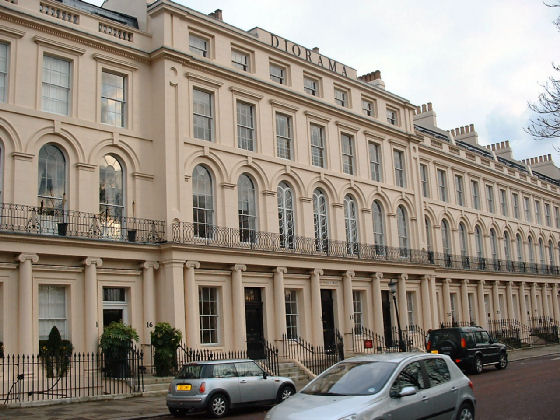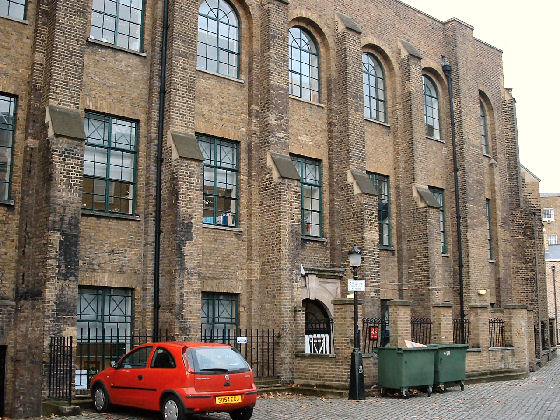History of the London Cinema - The Diorama

The famous French inventor Louis Daguerre brought his invention of the new technique to London in the 1820s and established a
Diorama at Park Square East Regents Park in 1823. The photo above shows the front of the cinema with the name DIORAMA still on the upper roof. The building is now used by the Princes Trust.
John Timbs, on ‘Diorama and Cosmorama’,
in his Curiosities of London, 1851;
"The Diorama, on the eastern side of Park-square, Regent’s-park, was exhibited in Paris long before it was brought to London by its originators, MM. Bouton and Daguerre; the latter, the inventor of the Daguerréotype died 1851. The exhibition-house, with the theatre in the rear; was designed by Morgan and Pugin: the spectatory had a circular ceiling, with transparent medallion portraits; the whole was built in four months, and cost £10,000. The Diorama consisted of two pictures, eighty feet in length and forty feet in height, painted in solid and in transparency, arranged so as to exhibit changes of light and shade, and a variety of natural phenomena; the spectators being kept in comparative darkness, while the picture received a concentrated light from a ground-glass roof."
The contrivance was partly optical, partly mechanical and consisted in placing the pictures within the building so constructed, that the saloon containing the spectators revolved at intervals, and brought in succession the two distinct scenes into the field of view, without the necessity of the spectators removing from their seats; while the scenery itself remained stationary, and the light was distributed by transparent and movable blinds - some placed behind the picture, for intercepting and changing the colour of the rays of light, which passed through the semi-transparent parts. Similar blinds, above and in front of the picture were movable by cords, so as to distribute or direct the rays of light.
The revolving motion given to the saloon was an arc of about 73 degrees and while the spectators were thus passing round, no person was permitted to go in or out. The revolution of the saloon was effected by means of a sector, or the portion of a wheel, with teeth which worked in a series of wheels and pinions; one man, by turning a winch, moved the whole. The space between the saloon and each of the two pictures was occupied on either side by a partition, forming a kind of avenue, proportioned in width to the size of the picture. Without such a precaution, the eye of the spectator, being thirty or forty feet distant from the canvas, would, by anything intervening, have been estranged from the object.
The combination of transparent, semi-transparent, and opaque colouring, still further assisted by the power of varying both the effects and the degree of light and shade, rendered the Diorama the most perfect scenic representation of nature; and adapted it peculiarly for moonlight subjects, or for showing such accidents in landscape as sudden gleams of sunshine or lightning. It was also unrivalled for representing architecture, particularly interiors, as powerful relief might be obtained without that exaggeration in the shadows which is almost inevitable in every other mode of painting. The interior of Canterbury Cathedral, the first picture exhibited, in 1823, was a triumph of this class; and the companion picture, the Valley of Sarnen, equally admirable in atmospheric effects. In one day (Easter Monday, 1824), the receipts exceeded £200.
In viewing the Diorama, the spectator was placed, as it were, at the extremity of the scene, and thus had a view across or through it. Hence the inventor of the term compounded it of the Greek preposition dia, through, and orama, scene; though, from there being two paintings under the same roof in the building in the Regent's-park, it is supposed the term was from dis, twice, and orama; but if several paintings of the same kind were exhibited, each would be a Diorama (Black).
Although the Regent’s-park Diorama was artistically successful, it was not commercially so. In September 1848, the building and ground in the rear, with the machinery and pictures, was sold for £6,750. Again, in June 1849 for £4,800; and the property, with sixteen pictures, rolled on large cylinder; was next sold for £3,000. The building has since been converted into a Chapel for the Baptist denomination at the expense of Sir Morton Pete, Bart.
The Cosmorama, though named from the Greek (Kosmos, world; and orama, view, because of the great variety of views), is but an enlargement of the street peepshow.
The Rotunda salon

Situated at the rear of the Diorama is the shell of the Rotundra designed by Augustus Charles Pugin to form part of the Diorama, this is all that remains with part of the wall and steps down to the foyer. This building is also part of the Prince's trust.
London Time

Follow Us
The contents of this website are the property of knowledgeoflondon.com and therefore must not be reproduced without permission. Every effort is made to ensure the details contained on this website are correct, however, we cannot accept responsibility for errors and omissions.
© Copyright 2004 -
Contact Us | Advertise